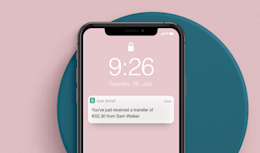

You’ve heard of SEPA payments, but what does it stand for, and how does it actually work? We unpack all you need to know about SEPA transfers here.
JUNE 06, 2024 8 min readThe SEPA (Single Euro Payments Area) is a pan-European network that allows you to send and receive payments in euros (€) between two cross-border bank accounts in the eurozone. With SEPA, sending money within the eurozone is as easy as making your usual domestic bank transfers.
There are three types of SEPA bank transfers, which offer three distinct services. Here’s how the SEPA Credit Transfer, the SEPA Instant Credit Transfer, and the SEPA Direct Debit Transfer work.
Banking jargon can be confusing—but it doesn't have to be. Find simple explanations to popular banking terms.

Usually used for one-off transfers, the SEPA Credit Transfer uses the IBAN (International Bank Account Number) and occasionally the BIC (Business Identifier Code) numbers of both the sender and the recipient’s bank accounts to move money from one bank account to another. Once the transfer is authorized, the recipient should receive their money within one business day after the payment was made. Say you wanted to send €500 from your bank account in Germany to your friend’s bank account in France. As both countries are within the SEPA region, this would work just like a domestic transfer with the SEPA Credit Transfer. First, your German bank would take €500 from your bank account. Then, by using the IBAN—and if necessary, the BIC—numbers to find the correct bank account, the €500 would then be deposited into your friend’s account by their French bank, all within one business day.
Also known as SEPA Instant Payment, the SEPA Instant Credit Transfer was established in November 2017. And true to its name, the SEPA Instant Credit Transfer is all about speed. Once the sender confirms a SEPA Instant Credit Transfer, the funds can be available in the recipient’s bank account in less than 10 seconds. This is because SEPA Instant Credit Transfers use direct routing from the sender’s bank to the recipient’s bank, without involving any intermediaries in the process. SEPA Instant Credit Transfers are also available 24/7, 365 days a year, unlike other banking procedures that may be delayed during the weekend or public holidays. However, to use the SEPA Instant Credit Transfer, both the sender and the receiver’s banks must be registered as SEPA Instant members. So before you hit send on a SEPA Instant Credit Transfer request, be sure to check that both your bank account and your friend’s bank account can accommodate SEPA Instant Credit Transfers.
SEPA transfers generally cost the same amount as a local domestic bank transfer, which means that they’re usually free. However, a small number of banks may charge you an extra fee for SEPA transfers if they also charge an extra fee to make local bank transfers within the same country. Depending on your bank, the SEPA transfer charge may either be paid in full by the recipient, or shared between both the recipient and sender. This is referred to as a “shared costs” (SHA) payment method. Additionally, there may be an extra currency conversion fee if multiple currencies are involved. For example, if you’re sending money from the UK to another EU country, your British pounds would have to be converted into euros. This can sometimes incur additional bank charges, so be sure to check with your bank before receiving a SEPA transfer from a different currency.
✓ 100% mobile ✓ No hidden fees ✓ No paperwork ✓ Free virtual Mastercard ✓ Free ATM withdrawals

With N26, getting your money where it needs to go is as simple as just a few taps on your phone. Send and receive money in the eurozone in seconds with SEPA Instant Credit Transfers, and manage all your finances in one simple, intuitive app. Need to send money a little further afield? No worries. You can now send money overseas in over 38 currencies at fair, real-market exchange rates. Ready for a 100% mobile bank with no hidden fees? Discover which N26 bank account fits you best.